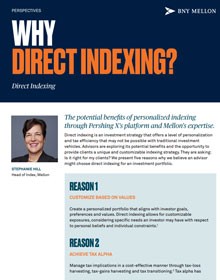The potential benefits of personalized indexing through Pershing X’s platform and Mellon’s expertise.
Direct indexing is an investment strategy that offers a level of personalization and tax efficiency that may not be possible with traditional investment vehicles. Advisors are exploring its potential benefits and the opportunity to provide clients a unique and customizable indexing strategy. They are asking: Is it right for my clients? We present five reasons why we believe an advisor might choose direct indexing for an investment portfolio.
Reason 1
Customize Based on Values
Create a personalized portfolio that aligns with investor goals, preferences and values. Direct indexing allows for customizable exposures, considering specific needs an investor may have with respect to personal beliefs and individual constraints.1
Reason 2
Achieve Tax Alpha
Manage tax implications in a cost-effective manner through tax-loss harvesting, tax-gains harvesting and tax transitioning.2 Tax alpha has been estimated to add an average 1.08% in additional after-tax returns for a U.S. high-tax-bracket investor.3,4 Direct indexing provides the opportunity to maximize tax management capabilities based on the client’s tax needs.
Reason 3
Mitigate Transition Ramifications
Minimize the tax consequences of moving assets into a new account.5 Direct indexing gives investors the opportunity to fund a new index portfolio with cash or existing securities via an intuitive tax scenario planning tool, which could help minimize the tax burden that comes with transition.
Reason 4
Diversify Concentrated Positions
Overconcentration may cause a risky situation for portfolios due to idiosyncratic risk. Direct indexing can potentially help investors by constructing a more diversified portfolio around a concentrated position, potentially reducing idiosyncratic risk exposure but maintaining stock- or sector-specific exposures they may want to keep.
Reason 5
Optimize Holdings
Indexes typically can be replicated by narrowing in on a small subset of components. Direct indexing seeks to provide index-like returns with similar characteristics of the benchmark even if an investor doesn’t own every index constituent.
Choose Precision and Performance
BNY Mellon Precision Direct IndexingSM leverages Pershing’s innovative platform6 and Mellon’s institutional-quality indexing expertise to provide advisors customized solutions at scale to deliver tax-efficient, customized beta exposure to their clients. Contact your relationship manager to find out more about BNY Mellon and Mellon’s indexing capabilities.
1 As of October 2023, the only target index available is the S&P 500® Index.
2 There's no guarantee that a particular investor will realize significant tax benefits from harvesting gains or losses. Investment strategies that seek to employ tax management may be unable to fully realize strategic gains or harvest losses due to various factors. Market conditions and/or client account holdings may limit the ability to generate tax losses. Tax-loss harvesting involves the risks that the new investment could perform worse than the original investment and that transaction costs could offset the tax benefit. Also, a tax-managed strategy may cause a client portfolio to hold a security in order to achieve more favorable tax treatment or to sell a security in order to create tax losses. Tax considerations, while important, are just one factor to consider before making any investment decision. Tax-managed investing and tax transitioning do not equate to comprehensive tax advice, are limited in scope and not designed to eliminate taxes in an account. Investors should contact their own tax advisor or financial professional for more detailed information on tax issues as they relate to your specific situation.
3 Tax alpha is the potential value generated by tax optimized solution based on the difference of excess pre-tax return and after-tax return. Estimates of tax alpha vary greatly across market conditions, but average to 1.08%, annualized over the period of study (1926 to 2018). Refer the study: An Empirical Evaluation of Tax-Loss-Harvesting Alpha, Chaudhuri et al Financial Analysts Journal (2020).
4 Tax alpha example is for illustrative/educational purposes only and is not intended to constitute legal, tax, investment or financial advice. The tax alpha example may not be applicable to or appropriate for every investor and should be used only after consultation with professionals who have reviewed an investor’s specific situation.
5 The ability to minimize tax consequences for a specific account may decrease as gains have the potential to accumulate over a period of time. Investors in lower tax brackets generally will not derive the same level of potential tax benefits from tax-managed strategies than those in higher tax brackets.
6 Clients must be appropriately contracted to use the Wove platform and all the associated services and tools including the Tax Transition Scenario Planner tool.
DISCLOSURE
All investments involve risk, including the possible loss of principal. Certain investments have specific or unique risks. No investment strategy or risk management technique can guarantee returns or eliminate risk in any market environment. Past performance is no indication of future performance. Diversification does not ensure a profit or protect against a decline in a down market.
This material has been provided for informational purposes only and should not be construed as investment advice or a recommendation of any particular investment product, strategy, investment manager or account arrangement, and should not serve as a primary basis for investment decisions. Prospective investors should consult a legal, tax or financial professional in order to determine whether any investment product, strategy or service is appropriate for their particular circumstances. This document may not be used for the purpose of an offer or solicitation in any jurisdiction or in any circumstances in which such offer or solicitation is unlawful or not authorized. Some information contained herein has been obtained from third party sources that are believed to be reliable, but the information has not been independently verified. No part of this material may be reproduced in any form, or referred to in any other publication, without express written permission.
Indices referred to herein are used for comparative and informational purposes only and have been selected because they are generally considered to be representative of certain markets. Comparisons to indices as benchmarks have limitations because indices have volatility and other material characteristics that may differ from the portfolio, investment or hedge to which they are compared. The providers of the indices referred to herein are not affiliated with BNY Mellon or its subsidaries, do not endorse, sponsor, sell or promote the investment strategies or products mentioned herein and they make no representation regarding the advisability of investing in the products and strategies described herein.
The Standard & Poor’s 500 (S&P 500®) Index is a widely accepted, unmanaged index of US stock market performance. Investors cannot invest directly in an index.
BNY Mellon Precision Direct Indexing accounts are not available to retirement plans covered under the Employee Retirement Income Security Act of 1974 (ERISA).
BNY Mellon Investment Management is one of the world’s leading investment management organizations encompassing BNY Mellon’s affiliated investment management firms and global distribution companies. BNY Mellon is the corporate brand of The Bank of New York Mellon Corporation and may also be used as a generic term to reference the Corporation as a whole or its various subsidiaries generally. This product may be offered by associated persons of BNY Mellon Securities Corporation (BNYMSC) acting in their capacity as investment adviser representatives. Mellon Investments Corporation (MIC) is composed of two divisions; Mellon, which specializes in index management, and Dreyfus, which specializes in cash management and short duration strategies. Securities are offered through BNY Mellon Securities Corporation (BNYMSC), a registered brokerdealer and affiliate of MIC. MIC provides day-to-day investment advisory services in connection with the product. Technology services provided by Pershing X, Inc. Other than this product, investment advisory services, if offered, may be provided by BNY Mellon Advisors, Inc., an investment adviser registered in the United States under the Investment Advisers Act of 1940 or one or more affiliates of BNY Mellon. BNYMSC, MIC and BNYMA are investment advisers registered in the United States under the Investment Advisers Act of 1940. Pershing X and BNYMA are affiliates of Pershing LLC, member FINRA, NYSE, SIPC. All firms are affiliated BNY Mellon subsidiaries. Pershing and Pershing X do not provide investment advice or offer investment advisory products or services. Since this is an advisory product, it is subject to an investment advisory fee.
For professional use only. Not intended for use by the general public.
©2023 BNY Mellon Securities Corporation, 240 Greenwich St., New York, NY 10286.




